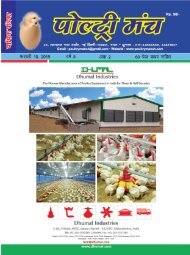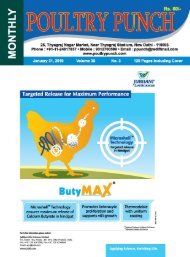POULTRY PUNCH - FEBRUARY 2019
POULTRY PUNCH - FEBRUARY 2019
POULTRY PUNCH - FEBRUARY 2019
- No tags were found...
You also want an ePaper? Increase the reach of your titles
YUMPU automatically turns print PDFs into web optimized ePapers that Google loves.
ARTICLE NEWS<br />
B<br />
(Canarypox-like virus)<br />
B1<br />
B2<br />
B3<br />
B4<br />
APVs affecting wild canaries, crows, finches, bustards, penguins, house<br />
sparrows, apapanes, grackles, song thrush and common murre<br />
Starlingpox and mynahpox virus<br />
Virginian pox viruses<br />
Macqueen’s bustard<br />
Replication of Fowlpox virus: The replication of FWPV occurs at the cytoplasm of the cell. During replication, inclusion<br />
bodies are develop which are the sites of virion assembly. The FWPV are identified in two forms – intracellular matured<br />
virus (IMV) and extracellular enveloped virus (EEV). Both these forms could productively infect cells by binding with the<br />
cellular membranes. Upon binding, the nucleocapsid is released into the cytoplasm of the cell. The released nucleocapsid<br />
encode early promoters that initiates transcription of early viral genes with the help of virus mediated RNA polymerase and<br />
transcription factors. The transcription of early viral genes induce extracellular modulators (viral growth factors, cytokine<br />
inhibitors), intracellular modulators (apoptosis inhibition, anti-viral state blockade, signalling modulators, host range factors)<br />
and initiate uncoating of the nucleocapsid which releases the genome. The genome encodes intermediate and late genes,<br />
which initiates transcription of intermediate and late gene viral products. During virion assembly, IMV is accumulated in the<br />
cytoplasm. The IMV obtains an envelope from Golgi body, to form intracellular enveloped virus (IEV). The release of IMV<br />
and IEV occurs either through cytolysis or virus induced exocytosis or by budding. The IEV upon being released from the<br />
cell is known as EEV.<br />
Tropism of Fowlpox virus: The tropism of FWPV is determined by three factors: entry into cells, ability to replicate<br />
and cause disease in the host. Based on these three factors, the hosts are classified into permissive and semi-permissive<br />
or abortive hosts. The permissive host include avian species, in which entry of FWPV is successful, replication of FWPV<br />
is complete and onset of disease is exhibited by clinical signs. The semi-permissive or abortive host include mammalian<br />
species, in which entry of FWPV is unrestricted, replication of FWPV is abortive and thus pathogenesis is absent.<br />
Fowlpox virus as vaccine vector: FWPV evolved as the most potential vector for poultry vaccines, because of the<br />
strategic prospects they have reported to offer, which includes:<br />
(i) the number of potential insertion sites they offer,<br />
(ii) their capacity to harbour large heterologous genes without altering its genome stability,<br />
(iii) their ability to replicate in the cytoplasm independent of host cell enzyme machinery eliminating the possibilities of<br />
insertional mutagenesis,<br />
(iv) their ability to undergo homologous recombination,<br />
(v) their ability to express high levels of heterologous genes,<br />
(vi) their ability to induce effective antibody-mediated immune response with high levels of protective antibodies and lasting<br />
cell-mediated immune response; and<br />
(vii) their ability to induce both T-helper cell and cytotoxic T-lymphocyte response.<br />
In poultry, FWPV was used as a vaccine vector to deliver S1 glycoprotein of IB virus, VP2 gene of IBD virus,<br />
haemagglutinin gene of AI virus, gB protein of ILT virus, envelope antigen of avian leucosis or sarcoma virus and MD virus.<br />
FWPV evolved as a vaccine vector in mammalian species due to its abortive replication in mammalian cells. It was<br />
used as a vaccine vector to deliver glycoprotein G of rabies virus and F protein of measles virus. It was reported that cellmediated<br />
immune response was induced against both the diseases, whereas humoral immune response was induced only<br />
against rabies virus and not measles virus. Further, it was used in Human Immunodeficiency virus and in oncolytic therapy.<br />
Limitations of usage of Fowlpox virus as vaccine vector: The major limitation of use of FWPV as a vaccine<br />
vector in poultry is the pre-existing immunity to FWPV. The pre-existing immunity is imparted either by prior exposure or<br />
by maternal immunity. Though previous infection reduces the efficiency of FWPV vaccine vectors, maternal antibody was<br />
neither reported to affect the replication of FWPV nor reported reduced expression of heterologous genes.<br />
References: 1.Jarmin, S., R. Manvell, R.E. Gough, S.M. Laidlaw and M.A. Skinner. 2006. Avipoxvirus phylogenetics:<br />
identification of a PCR length polymorphism that discriminates between the two major clades. J. Gen. Virol., 87:2191–2201.<br />
2. Davidson, I., I. Shkoda and S. Perk. 2008. Integration of the reticuloendotheliosis virus envelope gene into the<br />
poultry fowlpox virus genome is not universal. J. Gen. Virol.,89 (10): 2456 – 2460.<br />
3. Skinner, M.A., S.M. Laidlaw, I. Eldaghayes, P. Kaiser and M.G. Cottingham. 2005. Fowlpox virus as a recombinant<br />
vaccine vector for use in mammals and poultry. Expert Rev Vaccines., 4: 63 – 76.<br />
4. Weli, S. C.and M. Tryland. 2011. Avipoxviruses: infection biology and their use as vaccine vectors. Virol. J. 8: 49.<br />
60 February, <strong>2019</strong>






